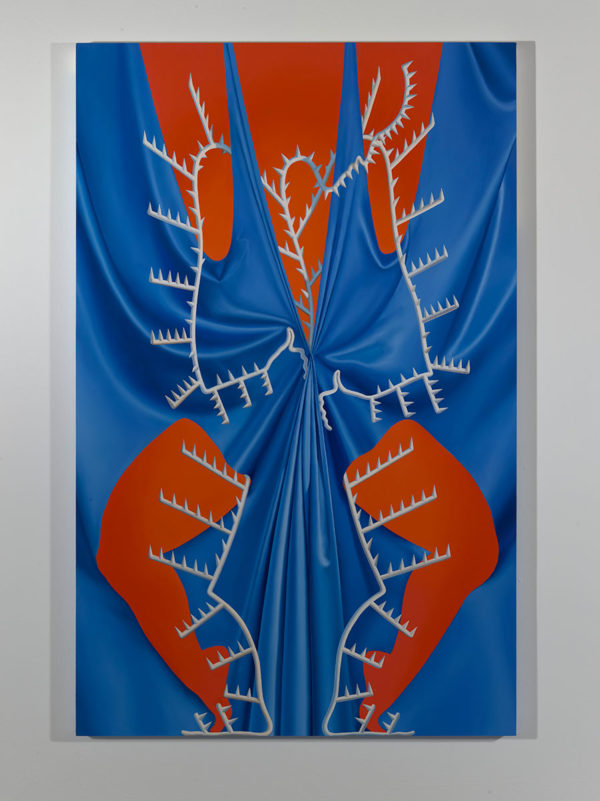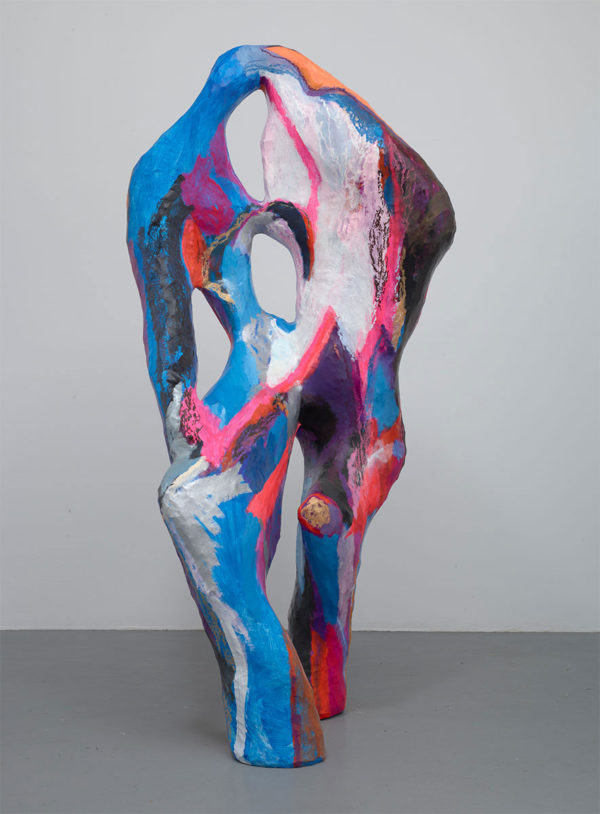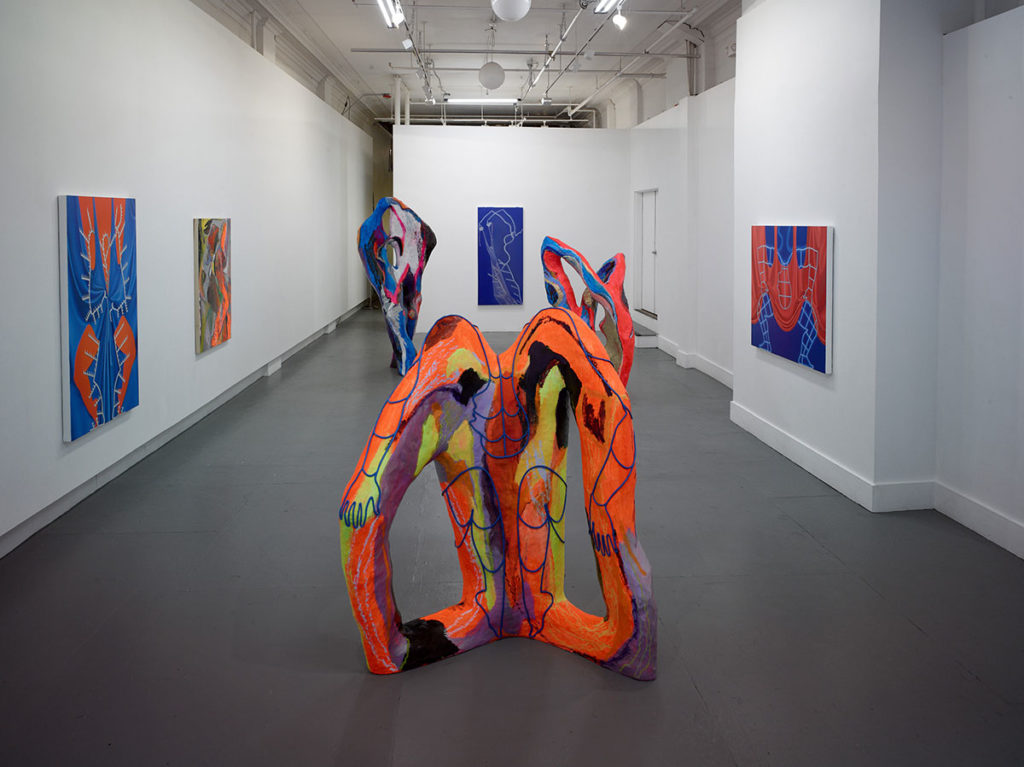by Jenna Crowder
In her essay “Pure Heroines,” cultural critic Jia Tolentino considers the visionary sociopolitical power of a process called affidamento. “Entrustment,” as it’s called in English, is a term that was coined by the Milan Women’s Bookstore Collective in the 1970s to describe a method, developed by Italian feminists, for pairs of women to create completely trusting relationships that would allow them to examine and reflect their differences — as opposed to their similarities — in order to exalt each woman’s autonomy and individuality as complements to one another, opening new space for growth for each person.1 Spending time with the paintings, sculptures, and works on paper by Bianca Beck and Sascha Braunig in their exhibition Extra Spectral, I couldn’t help but recall the idea of affidamento and the feminist and political reverberations that feel just as radical nearly fifty years later. Throughout the exhibition — which is on view at SPACE through January 11 — Beck and Braunig evoke the fundamental principles of witnessing and narrating difference that are so integral to the practice of entrustment.

The figures in Braunig’s paintings always look as if they are performing. Twisting, folding, arcing, hiding, and teasing, these characters also exhibit a range of survival and coping mechanisms, such as thick thorns or spikes along wire forms in pained postures as in Halter (2019) or the sarcastic and melancholy resignation of giving two icon-like thumbs-up in Deep V (2019). Braunig’s figures have mass that is suggested — both from the way their contours are formed as well as the fact that she paints from three-dimensional models — but in reality this mass is almost nonexistent. These bodies are rendered to look as if made of wire or light, or shaped by negative space — in the latter case, often by red satin draped in front of a field of blue, or vice versa. In other words, these figures are so thin as to seem easily bendable or legible only when defined by something else — qualities the Milan Women might find illustrative of the way language and philosophy have been developed to determine that women are not themselves on their own terms, but instead as “not men,” a problem of othering that extends throughout gender spectra.2 Despite their actual state of being genderless I usually read these figures as women; either correctly receiving Braunig’s signals or maybe catching myself in a sorry mixture of implicit bias and involuntary transposition of the author onto her work. A satisfying contradiction emerges in looking closely: though the paintings appear impeccably smooth from even a few feet away, the surfaces don’t attempt to hide the brushstrokes that made them.

Beck’s sculptures also take the figure as their subject. These are made from wood and papier-mâché and are painted thickly and freely in shades of electric tangerine, neon pink, lemon, and cooler palettes of haint blue to Egyptian blue to azure to cobalt as in Untitled (2019), a tall figure who could be breakdancing or voguing, maybe duckwalking or catwalking. Beck’s sculptures, in their declarative presence, appear to move in distinct and exaggerated ways — exuberantly, timidly, even restfully — either as individuals or as various moods or expressions of singular character. (The fact that all of Beck’s sculptures are untitled only adds to this sense of both/and.) Her sculptures delight in taking space and require their viewer to yield to them. Where Braunig’s figures feel wraithlike and ephemeral, Beck’s feel absolutely material. These sculptures define themselves and define the space to dictate how we, as beholders, move in it. They take their inspiration from, as Beck has cited, women like the singer, producer, and fashion icon Grace Jones and the feminist writer, philosopher, and activist Grace Lee Boggs. Thinking again of the Milan Women, I sense they might feel vindicated in Beck’s outwardly matrilineal approach to making.
Cementing my sense of entrustment in Extra Spectral is the collaborative sculpture, Untitled (2019), by Beck and Braunig that sits immediately at the front of the gallery, declaring from the beginning the care to be expected in this exhibition. A seated papier-mâché figure painted in blaze orange, bruise colors, and black and yellow bile (by Beck) is embraced sweetly from behind by a sculptural sapphire contour figure (by Braunig) — a version of her painted wiry forms, maybe an original model itself — that wraps its blue legs around the yellow body. We can discern no head atop Beck’s figure, but Braunig’s form lends her one, draping her outlined skull lovingly over her friend’s neck and chest. In turn, Braunig’s figure achieves dimensional materiality and self-definition.
Several framed works on paper by both Beck and Braunig are hung in the gallery’s back room, including one, “Study for collaboration,” made together for their co-authored sculpture. These sweet, gestural works — by their nature as studies — are hung in pairs and read quicker, as calls-and-response or mirrors or translations; in all scenarios we glimpse an intimate conversation.
Beck and Braunig currently live and maintain studios in the Portland area. While both have enjoyed significant success in New York and Europe respectively, it’s an exciting opportunity to see these accomplished women in their first two-person show in Maine. Their collaborative practice and artistic relationship — whether or not they might name it as affidamento — affirm and celebrate one another’s individuality and complexity. By witnessing each other’s histories, artistic media, and lived experiences — particularly by navigating their differences — Beck and Braunig locate themselves in multi-directional spectra of identities independent of otherness.
Extra Spectral, featuring work by Bianca Beck and Sascha Braunig, is on view at SPACE through January 11, 2020.
SPACE
538 Congress Street, Portland, Maine | 207.828.5600
Open Wednesday – Friday 10am–6pm, and Saturday 12–4pm.
- This process, Tolentino notes, is similar to the politics of difference that the feminist writer and civil rights activist Audre Lorde advocated for in the United States around the same time. See Jia Tolentino, “Pure Heroines” in Trick Mirror: Reflections on Self-Delusion, Random House, 2019. ↩
- See Teresa de Lauretis’ introduction to The Milan Women’s Bookstore Collective, Sexual Difference: A Theory of Sexual Symbolic Practice, Indiana University Press, 1990. ↩

Jenna Crowder, Co-Founding Editor at The Chart, is an artist, writer, and editor. Her writing has been published in The Brooklyn Rail, Art Papers, BURNAWAY, Temporary Art Review, The Rib, Liminalities: A Journal of Performance Studies, and VICE Creators Project, among other places.

